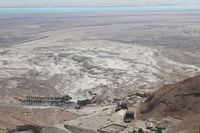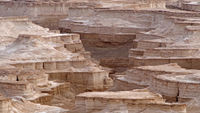Gomorrah
 From Conservapedia
From Conservapedia 
Gomorrah, ancient city located in the Holy Land, and one of the five "cities of the plain" that were destroyed by an act of God for their extreme wickedness, as recorded in the Book of Genesis. According to the biblical account, God rained fire and brimstone onto the city, killing all of the inhabitants.[1]
Contents
- 1 Biblical background
- 2 Etymology
- 3 Ruins described
- 4 References
- 5 External links
Biblical background[edit]
The cities are the subject of a passage in the Bible (Genesis 18 & 19). God himself sought out Abraham in the guise of three angels in male form, to inform him that he planned to destroy the cities of Sodom (where Abraham's nephew Lot resides) and Gomorrah, if the sinful behavior of their inhabitants was indeed as evil as He heard. Abraham asked God if he really wanted to destroy guilty and innocent people without distinction, with God assuring him that he would spare Sodom if as few as ten righteous people could be found living in it (Gen 18:16).
To see if the lamentation over Sodom was true, God sent two angels to Abraham's nephew Lot, a godly man. Lot welcomed the angels, who were regarded by the inhabitants of Sodom as foreign men (Gen 19:6). The inhabitants then demanded that Lot give these men over to themselves, for violent homosexual abuse. Instead, Lot offered his virgin daughters in vain for the protection of his guests.
Since ten righteous people could not be found – the number is actually four: Lot and his family – God doomed the city to destruction, and the angels saved him and his family from the downfall and sent them out of the city. Sodom and Gomorrah were then destroyed by a rain of fire and brimstone that fell upon them. When Lot's wife – contrary to a prohibition pronounced by the angels – looked back on the city, she was changed into a pillar of salt (Gen 19). Lot and his daughters were safe.
Etymology[edit]
The English name "Gomorrah" has its basis in the Hebrew word עמרה' "‛ămôrâh", which in turn is based on עמר "‛âmar", a primitive root word meaning "heap", which could be taken to mean either the ruined stated of the city, or the amount of goods or grain gathered together for sale or trade, such was the richness of the city when alive and inhabited. In a figurative sense, "‛âmar" meant also to chastise, as if inflicting blows against someone[2]. The Brown-Driver-Briggs definition carries it further, to manipulate or deal tyrannically, as one would treat a slave[3].
Ruins described[edit]

Sodom and Gomorrah has been cited by modern scholars as being on the southern or southeastern side of the Dead Sea, in Jordan, as being either the remains of Tall el-Hammam[4] or Bab edh-Dhra[5]. Both cities did exist during the Bronze Age, 3200–1100 BC, with Bab edh-Dhra collapsing ca 2300 BC, approximately 200 years prior to the destruction of the cities of the plain as described in the Bible. It is largely unknown what caused their destruction and abandonment, with warfare, earthquakes, and a comet impact being cited as causes.
The Jewish historian Josephus stated that he saw the ruins of the site, describing the location and the condition of the ruins: "The country of Sodom borders upon it. It was of old a most happy land, both for the fruits it bore and the riches of its cities: although it be now all burnt up...the traces [or shadows] of the five cities are still to be seen...but if you pluck them with your hands, they dissolve into smoke, and ashes."[6]. As this describes a site composed primarily of ash which crumbles in the hand, then Tall el-Hamman and Bab ed-Dhra both must be discounted.
The actual remains of Gomorrah are located on the western shore of the Dead Sea, close to the foot of Masada. The site itself is lightly-colored, as opposed to the immediately-surrounding area. Visually, the remaining structures consists of high walls - often double-walls in which the upper course was set back - and piles of ash debris sloping their sides into the wadis. Right angles appear, both horizontally and vertically, in many places, as well as the remains (or shadows", in keeping with Josephus' description) doorways, gateways, and windows.
The structures themselves are made up of calcium sulfate (CaSO4), a substance which is best known as the mineral gypsum. However, calcium sulfate can be made as a by-product when limestone is subject to intense heat caused by burning sulfur[7]; indeed, many ancient cities within the Holy Land, including Jerusalem, were constructed with limestone, as it is abundant and easily quarried. Sulfur - the Biblical "brimstone" - is abundant here as well, found embedded in the walls and ground, often as little round balls, and more than 98% pure[8].
References[edit]
- ↑ Genesis 19:24
- ↑ https://biblehub.com/hebrew/6014.htm
- ↑ https://biblehub.com/hebrew/6014.htm
- ↑ https://www.forbes.com/sites/davidbressan/2018/11/29/is-the-biblical-destruction-of-sodom-and-gomorrah-based-on-a-real-life-impact-event/#d56fa584c292
- ↑ https://www.bibleplaces.com/babedhdhra/
- ↑ https://penelope.uchicago.edu/josephus/war-4.html#S8.4
- ↑ https://www.arkdiscovery.com/sodom_&_gomorrah.htm
- ↑ https://www.oxfordbiblechurch.co.uk/index.php/books/sodom-and-gomorrah/633-appendix-2-results-of-a-scientific-analysis-of-gomorrah
External links[edit]
- What was the sin of Sodom and Gomorrah?, Got Questions.
- Lacey, Troy (August 3, 2019). What Was the Primary Sin in Sodom and Gomorrah? Answers in Genesis.
- Genesis 19
| ||||||||
Categories: [Biblical Places]
↧ Download as ZWI file | Last modified: 02/27/2023 18:21:22 | 16 views
☰ Source: https://www.conservapedia.com/Gomorrah | License: CC BY-SA 3.0
 ZWI signed:
ZWI signed: KSF
KSF